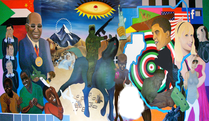Louis Vuitton bags and intellectual property
Yesterday, by pure chance, I discovered an absurd story. Nadia Plesner is a Dutch Danish painter. Her last work is Darfurnica, a modern version of Picasso’s Guernica that you can see in the thumbnail here.

For reasons explained on her website, Plesner mixed in the painting stories about Darfur with Hollywood gossip.
Here’s the problem: the kid in the center of that painting is carrying a bag. Not a generic bag, mind you: it turns out that that kid is carrying something very similar to a Louis Vuitton Audra bag. A bag, that is, as I learned on Google’s first result for that name that constitutes “Louis Vuitton’s first stab at a new direction for the multicolore range as well”.
Personally, I had to look at that big image twice, after reading PLesner’s text, before understanding what she was talking about. This is relevant, because it means that, in and by itself, her painting would have never caused in me and, I’m sure, many millions of other people any of the negative associations whose only possibility sent Louis Vuitton in flames.
Understandably, when you’re doing something so crucial for the future of humankind as testing a new direction for multicolor bags you don’t want any negative publicity, nor you want others making money out of your wonderful idea. Therefore, in 2008 Louis Vuitton sued Plessner for infringement of design rights and now sued again, asking 5000 euro penalties for each day (since January 28th, 2011) that painting is exposed on her website or in galleries or anywhere else. Louis Vuitton says (paragraphs 14 to 18) that Plesner has recently been offering for sale several works containing the kid with the bags, therefore “it is clear that she intends to attract the public’s attention to her own products by using the intellectual property rights of Louis Vuitton, and in doing so is free riding on the public profile of Louis Vuitton and the media attention which the dispute between Louis Vuitton and Plesner has generated in 2008”.
What’s the link between luxury bags and digital rights?
Before explaining it, let me make clear one thing. Personally, I do agree with fashion multinationals when they say that you should never buy fakes of their products. The claims of mountains of money lost to fake products are so totally bogus to be embarrassing, because almost everybody who buys a fake has no money to buy the original, period. However, as you can read here and here many fake luxury goods are cheap only thanks to child labor, sweatshops and terrible working conditions. This said, I would really like to ignore cases like this, but here’s why a Louis Vuitton bag is on a website dealing with digital rights.
I have no final opinion about Plesner yet, and you can even find online other people, not Louis Vuitton, attacking her. The problem here is not that multinationals want to block people who make money by selling duplicates of their products in the streets or online. That’s not news, is it?
The general problem behind the Plesner/Darfur/Louis Vuitton case is free speech online and the mess that can happen if you try to control all possible appearances of an idea or concept in a world that is more wired every day.
As Branko Collin said the real problem of cases like this is corporations using excuses to control any conversation about them, even when they are not the real main topic. The fact that they try to do it in a world that they don’t really understand is even more worrying.
If you search for “Louis Vuitton Audra” on Flickr you’ll find something similar to this screenshot. The first picture is an “Audra-like birthday cake”, for heaven’s sake! What should that guy do now? Pay Louis Vuitton 5000 Euros for each person that ate that cake? Speaking of Africa, we westerners send literally tons of used dresses to Africa every month. If a reporter or tourist photographed a dying kid that happens to be wearing a designer shirt, should he give all the money made with that picture to that designer, or not publish it at all to not hurt sales of that brand?
If I had money to waste, I’d buy a real Audra bag NOW. Then I’d fly to Darfur, give it to the first undernnourished or wounded kid I met, photograph him and post the picture online, simply to see what the lawyers would say. I have no such money, but there’s one thing I’m sure about. Until this morning, I couldn’t have told a Louis Vuitton Audra bag from a martian fountain. From now on, every time I’ll met somebody carrying that bag, I’ll have to fight the urge to tell her “hey, that’s the bag from those guys that sue painters! How glamorous!” Should I?
Who writes this, why, and how to help
I am Marco Fioretti, tech writer and aspiring polymath doing human-digital research and popularization.
I do it because YOUR civil rights and the quality of YOUR life depend every year more on how software is used AROUND you.
To this end, I have already shared more than a million words on this blog, without any paywall or user tracking, and am sharing the next million through a newsletter, also without any paywall.
The more direct support I get, the more I can continue to inform for free parents, teachers, decision makers, and everybody else who should know more stuff like this. You can support me with paid subscriptions to my newsletter, donations via PayPal (mfioretti@nexaima.net) or LiberaPay, or in any of the other ways listed here.THANKS for your support!